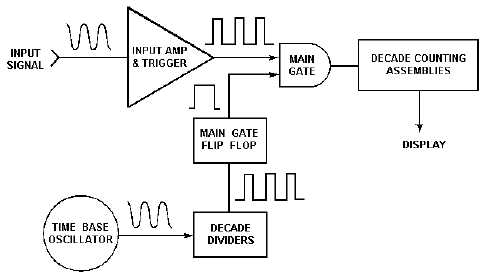5-16
Frequency Measurement
As discussed previously, the model 5328A frequency counter is capable of measuring frequency,
time period (inverse of frequency), ratio, and time interval. We will start with frequency. When the
FUNCTION selector is in the FREQ A or FREQ C position, the counter measures the frequency, f, by
accumulating the number of cycles, n, of the input signal that occurs over the time period, t. This is
expressed by:
The basic counter elements necessary to perform this measurement are shown in figure 5-12. The
INPUT AMPLIFIER/TRIGGER essentially conditions the input signal to a format that is compatible with
the internal circuitry of the counter. As figure 5-12 indicates, the output of the amplifier/trigger
corresponds directly to the input signal.
Figure 5-12.—Basic elements of the frequency counter.
The TIME BASE OSCILLATOR is a 10-MHz temperature-controlled (oven-regulated) precision,
crystal oscillator used for the time base element from which time, t, is derived. DECADE DIVIDERS
take the time base oscillator signal as the input and provide a pulse train, whose frequency is variable in
decade steps. This frequency can be controlled by the FREQ RESOLUTION, N switch. The time, t, is
determined by the period of this pulse train.
The heart of the counter is the MAIN GATE. When the gate is opened, pulses from the
amplifier/trigger are allowed to pass through. The opening and closing of the main gate is controlled by
the decade divider output to the main gate flip-flop. The output of the MAIN GATE is then sent to the
DECADE COUNTING ASSEMBLIES (DCAs), where the pulses are combined and displayed after the
gate is closed.
If the FREQUENCY RESOLUTION, N selection switch, is set for 10
6, the main gate is open for 1
second, and the decade counting assemblies display the frequency of the input signal in hertz (refer to
figure 5-10, FREQUENCY RESOLUTION, N selection switch).



